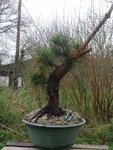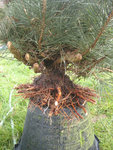roberthu
Chumono
Today I visited a local grower who has been growing some materials in his farm for over 25 years and some of the JBP are absolutely powerful (5" plus trunk). After placing a few orders to be dug up in the coming spring, we started talking about repotting. He said the soil in the farm are mostly red clay and they fall loose very easily during the digging process and that made me worry that I may not have an intact root ball with enough native soil next year. However, the owner and another hobbyist told me they actually bare rooted and washed these JBP’s without any issue. As a matter of fact, these JBP just kept growing like nothing happened. This made me wonder about why we hear conifers should not be bare rooted. After all, balance of water and oxygen is the key and clay usually holds way too much water and not enough oxygen.
Ryan Neil has said in multiple videos that with nursery stock or collected materials, the roots will grow into the APL mix easily because it is superior to clay or other organic soil in regards to the balance of water and oxygen. So why don’t we replace all soil in one go? Is it just to preserve beneficial bacteria? If so, then there are products that will promote beneficial bacteria to colonize. Can we just use that and get all fresh soil in the pot to promote better root growth?
Ryan Neil has said in multiple videos that with nursery stock or collected materials, the roots will grow into the APL mix easily because it is superior to clay or other organic soil in regards to the balance of water and oxygen. So why don’t we replace all soil in one go? Is it just to preserve beneficial bacteria? If so, then there are products that will promote beneficial bacteria to colonize. Can we just use that and get all fresh soil in the pot to promote better root growth?



